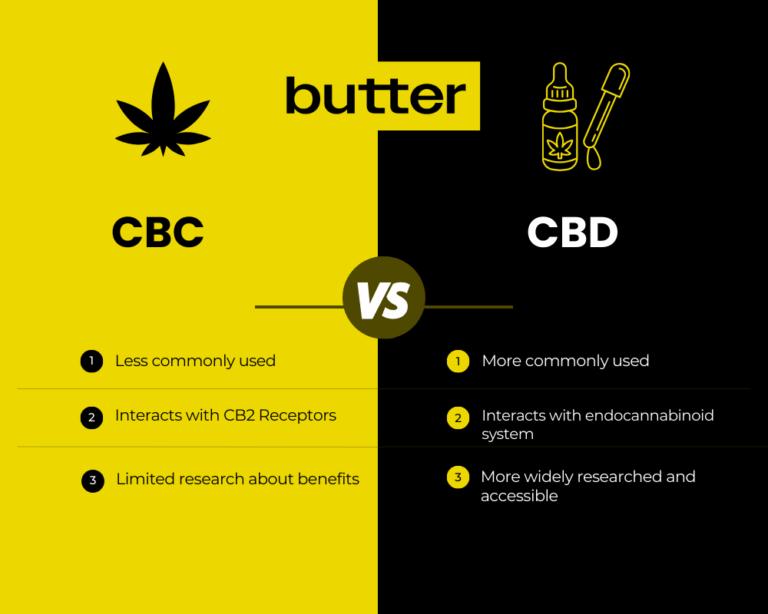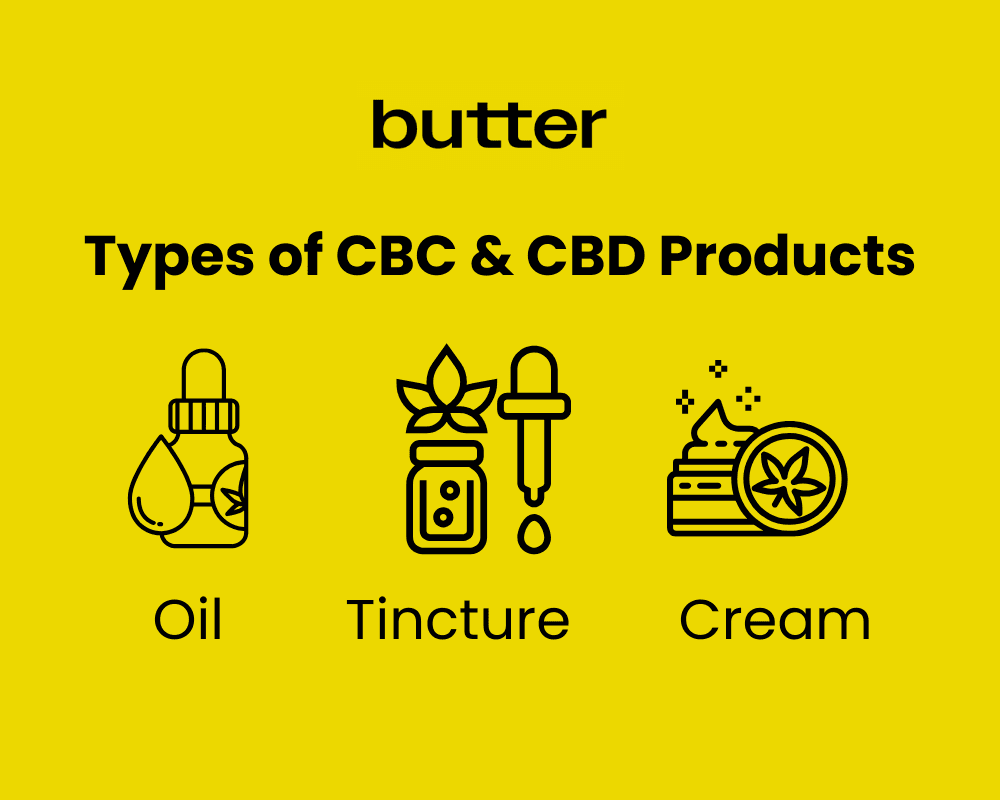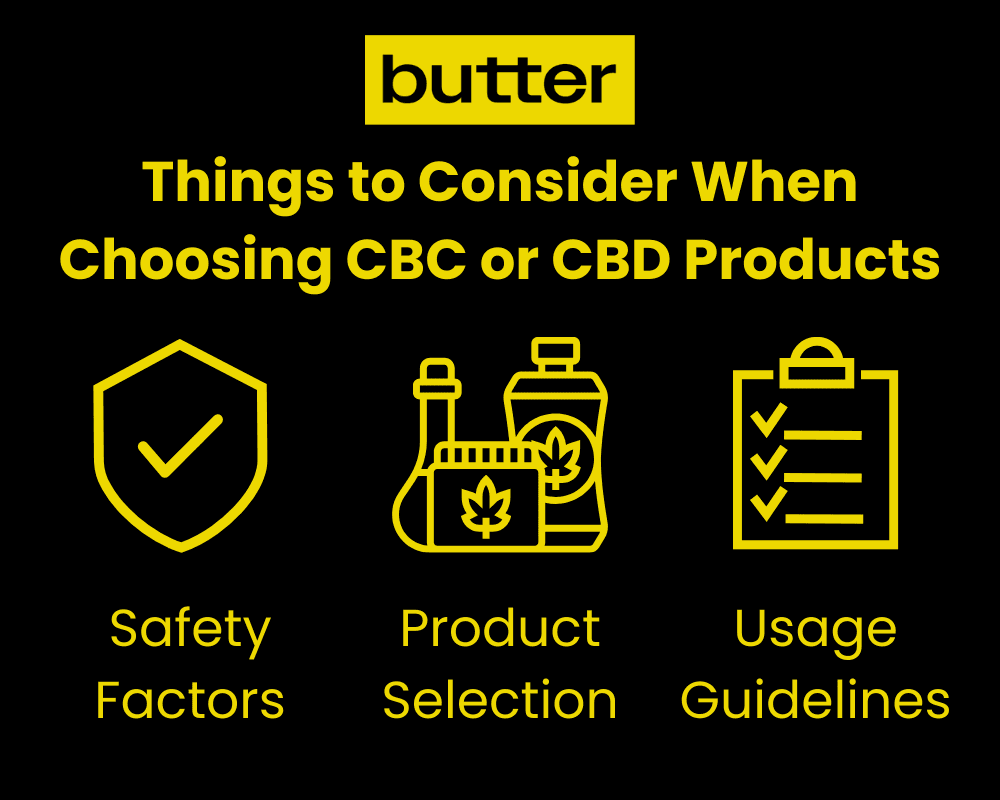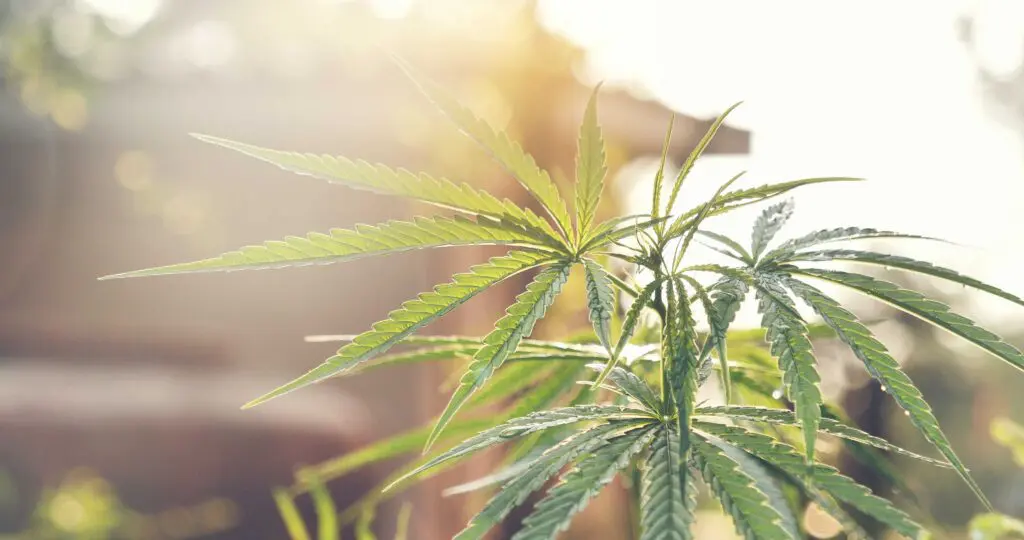Table of Contents
The cannabis plant is a remarkable source of natural compounds, with cannabinoids being among its most intriguing components. While most cannabis enthusiasts are familiar with CBD (cannabidiol), the lesser-known cannabinoid CBC is from the same parent compound, CBGA (cannabigerolic acid). These different cannabinoids offer distinct properties and benefits that make them unique.
Understanding the differences between CBC and CBD isn’t just about scientific curiosity – it’s about making informed decisions about your cannabis consumption. These two cannabinoids, though similar in origin, serve different purposes in cannabis products. Whether you’re a seasoned consumer or new to cannabis products, knowing how these compounds work can help you better appreciate their individual roles, different effects, and potential benefits.

The Basics of CBC and CBD
Both CBC (cannabichromene) and CBD (cannabidiol) are natural compounds found in the Cannabis sativa plant, though they play distinctly different roles in how they interact with the human body.
Origins and Production
CBC and CBD share common roots in their production within the cannabis plant. Both begin their journey from the same parent molecule – cannabigerolic acid (CBGA), which is often called the “mother cannabinoid.” Through specific enzymatic processes within the plant, CBGA is converted into different compounds. For CBD, the pathway leads through cannabidiolic acid (CBDA), while CBC develops through cannabichromene carboxylic acid (CBCA). Both compounds reach their final forms after exposure to heat or ultraviolet light, a process known as decarboxylation.
Key Differences
While both compounds originate from the same plant, they interact with the body in notably different ways. CBC is high in cannabichromene (CBC), a non-psychoactive cannabinoid found in the cannabis plant. It primarily binds with specific receptors involved in pain perception and inflammatory responses. When CBC activates these receptors, it triggers the release of naturally occurring endocannabinoids in the body, particularly anandamide.
CBD, in contrast, doesn’t bind directly with these receptors, but instead influences how other compounds interact with them. CBD also affects multiple molecular targets in the body. It works by modulating various cellular pathways and can influence how the body processes other cannabinoids.
The impact on the brain and body differs between these compounds as well. CBC is non-intoxicating because it binds poorly to CB1 receptors in the brain, which are responsible for psychoactive effects. Similarly, CBD doesn’t cause intoxication, but it can influence brain signaling through different mechanisms, such as affecting calcium levels in brain cells and reducing inflammation.
Effects and Benefits
Recent research has illuminated the diverse therapeutic potential of both CBC and CBD, with each compound offering unique benefits through different mechanisms of action.
CBC Applications
CBC (cannabichromene) has emerged as a promising cannabinoid with several notable applications. Research indicates CBC’s effectiveness in managing pain and inflammation through its interaction with specific receptors in the body. CBC offers an alternative approach to inflammation control with potentially fewer side effects.
A 2013 study revealed CBC’s potential for positive impact on neural stem progenitor cells (NSPCs), which are crucial for brain function. According to the study, these cells can:
- Help maintain brain homeostasis
- Defend against oxidative stress
- Potentially offering protection against neurological conditions
CBC has also demonstrated promise in cancer research, where it ranks as the second-most-potent cannabinoid in inhibiting the growth of cancer cells. While more research is needed, early studies suggest CBC may work by interacting with the body’s natural endocannabinoid system.
CBC has shown significant potential in acne treatment. Initial research has demonstrated its ability to reduce sebum production and inflammation in sebaceous glands, while also decreasing levels of arachidonic acid, which contributes to acne formation.
CBD Applications
CBD has established itself as a versatile compound with widespread applications. The United States Congress legalized CBD that comes from hemp in 2018, so it is used in a variety of products. It has gained particular recognition for its anxiety and stress-relieving properties, making it a popular choice for those seeking natural mental wellness support. Clinical studies have shown CBD’s effectiveness in reducing anxiety symptoms without the psychoactive effects associated with THC.
Pain management represents another significant application for CBD, particularly for chronic pain conditions. CBD helps reduce pain signals while supporting the body’s natural pain management systems.
CBD has also shown promise in supporting healthy sleep patterns, making it a valuable option for those struggling with sleep issues. Its calming properties help promote relaxation without the morning grogginess often associated with traditional sleep aids.
In terms of inflammation reduction, CBD works through multiple pathways in the body to help manage inflammatory responses. This makes it particularly useful for various conditions where inflammation plays a key role. CBD’s anti-inflammatory effects and antioxidant properties also make it effective for various skin conditions, helping to maintain skin health while potentially reducing issues like redness and irritation.

CBC and CBD Products
Both CBC (cannabichromene) and CBD (cannabidiol) are available in various product forms designed to meet different needs and preferences. While both compounds originate from the cannabis plant, they offer distinct benefits and can be found in several delivery methods.
Oils
One of the most popular forms of both CBC and CBD products, these concentrated liquids are typically placed under the tongue using a dropper, allowing for quick absorption into the bloodstream. CBC oils are often combined with carrier oils like MCT or hemp seed oil, while CBD oils come in various concentrations for flexible dosing.
Tinctures
Containing either CBC or CBD extracted using alcohol or glycerin bases, these formulations often include additional beneficial compounds from the hemp plant and can be easily mixed into beverages or taken directly under the tongue.
Gummies
These edible products, which have become increasingly popular due to their convenience and precise dosing, offer a simple way to consume either CBC or CBD with pre-measured amounts in each piece. Dispensaries typically stock a variety of flavors and potency options to suit different preferences.
Creams
Topical creams infused with CBC or CBD provide targeted pain relief when applied directly to the skin. These products are particularly popular among those seeking localized benefits without internal consumption. The creams often combine these cannabinoids with other soothing ingredients for enhanced effects.

Safety Considerations
When exploring CBC or CBD products, understanding key safety factors is essential for cannabis consumers. Both cannabinoid compounds interact differently with medications, so consult your healthcare provider before starting use, especially if you take prescription drugs.
Product Selection
Quality indicators are crucial when selecting CBC or CBD products from Michigan dispensaries. Look for products with certificates of analysis from independent, third-party laboratories. These tests should verify cannabinoid content and confirm the absence of contaminants like pesticides, heavy metals, and residual solvents. Avoid products that don’t clearly state their extraction method or lack transparent lab testing information.
Choosing the type of cannabis product can also depend on the individual’s preferences. Oils offer precise dosing and longer-lasting effects, while vaporization provides faster onset. Topical applications work well for localized relief. Effects can last 4-6 hours for most delivery methods, though edibles may extend to 6-8 hours. Whether it’s an oil, cream, or a gummy, CBC and CBD can be packaged in forms that many different customers can enjoy.
Usage Guidelines
For CBD products, typical starting doses range from 5-10mg, while CBC dosing guidelines are still being established through research. The timing of consumption depends on your intended use – morning doses for daytime relief, evening doses for sleep support. Effects generally begin within 30-90 minutes for oral products and 15-30 minutes for inhaled forms.
Consider the method of administration carefully and document your usage and responses to find your optimal approach while staying within recommended limits.

Explore Cannabis Products at butter Dispensary
While both CBC and CBD offer unique properties as cannabinoids, they serve distinct purposes in the cannabis wellness landscape. CBD remains the more thoroughly researched compound, known primarily for its potential anti-inflammatory and calming effects. CBC, though less studied, shows promise, particularly in areas of mood support and skin health. The key difference lies in their interaction with the body’s endocannabinoid system: CBD works primarily through indirect mechanisms, while CBC appears to have more direct effects on specific cannabinoid receptors.
butter Dispensary offers CBD products and other cannabis offerings in the Ann Arbor and Berkley, Michigan areas. Visit one of our dispensaries or make an online purchase to find a product that’s the perfect fit for you.
